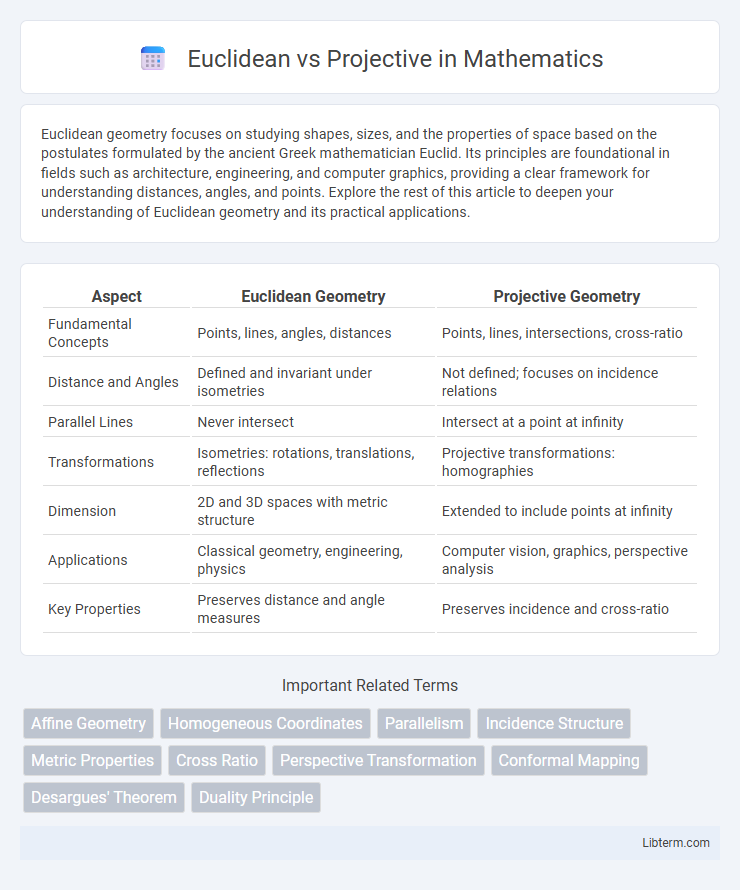Euclidean geometry focuses on studying shapes, sizes, and the properties of space based on the postulates formulated by the ancient Greek mathematician Euclid. Its principles are foundational in fields such as architecture, engineering, and computer graphics, providing a clear framework for understanding distances, angles, and points. Explore the rest of this article to deepen your understanding of Euclidean geometry and its practical applications.
Table of Comparison
| Aspect | Euclidean Geometry | Projective Geometry |
|---|---|---|
| Fundamental Concepts | Points, lines, angles, distances | Points, lines, intersections, cross-ratio |
| Distance and Angles | Defined and invariant under isometries | Not defined; focuses on incidence relations |
| Parallel Lines | Never intersect | Intersect at a point at infinity |
| Transformations | Isometries: rotations, translations, reflections | Projective transformations: homographies |
| Dimension | 2D and 3D spaces with metric structure | Extended to include points at infinity |
| Applications | Classical geometry, engineering, physics | Computer vision, graphics, perspective analysis |
| Key Properties | Preserves distance and angle measures | Preserves incidence and cross-ratio |
Introduction to Euclidean and Projective Geometry
Euclidean geometry focuses on flat spaces characterized by parallel lines and fixed distances based on the Euclidean metric, primarily studying points, lines, and planes within two- or three-dimensional space. Projective geometry extends these concepts by incorporating points at infinity, allowing the analysis of properties invariant under projection, and emphasizing the relationships between points and lines beyond measures of distance and angle. Both geometries underpin different mathematical frameworks, with Euclidean geometry rooted in metric concepts and projective geometry centered on incidence and continuity without relying on notions of length or angle.
Historical Background and Evolution
Euclidean geometry, formulated by the ancient Greek mathematician Euclid around 300 BCE, laid the foundational principles of flat space and rigid transformations based on axioms in "Elements." Projective geometry emerged during the Renaissance through the work of mathematicians like Girard Desargues and Blaise Pascal, extending classical geometry by introducing concepts like points at infinity and perspective transformations. The evolution from Euclidean to projective geometry revolutionized mathematical understanding by generalizing geometric properties invariant under projection, fundamentally impacting art, engineering, and modern computer vision.
Fundamental Concepts: Points, Lines, and Planes
Euclidean geometry centers on points, lines, and planes with fixed measurements and angles, emphasizing parallelism and distance. Projective geometry, however, studies these elements through properties invariant under projection, where parallel lines intersect at a point at infinity. This fundamental shift allows projective geometry to unify and extend the concepts of perspective and invariance beyond the constraints of Euclidean space.
Key Differences Between Euclidean and Projective Geometry
Euclidean geometry studies shapes and distances within flat, two-dimensional planes defined by parallel lines and fixed angles, focusing on concepts like congruence and similarity. Projective geometry extends these ideas by incorporating points at infinity where parallel lines intersect, allowing transformations that preserve collinearity but not necessarily distances or angles. Key differences include Euclidean geometry's reliance on metric properties such as length and angle measurement, while projective geometry emphasizes properties invariant under projection, such as cross-ratio and alignment.
Parallelism: Euclidean vs Projective Perspective
Euclidean geometry maintains parallelism as a fundamental property where parallel lines never intersect, preserving consistent angles and distances. Projective geometry, however, redefines parallel lines as intersecting at a point at infinity, altering the traditional concept of parallelism and enabling the representation of perspective in visual space. This difference allows projective geometry to model real-world perspectives better, such as how parallel railroad tracks appear to converge in the distance.
Role of Infinity and the Point at Infinity
In Euclidean geometry, the concept of infinity is not formally included within the space, as lines extend indefinitely without closure, lacking points at infinity. Projective geometry introduces the point at infinity to each family of parallel lines, effectively closing the geometry and enabling intersections of all lines, thus unifying finite and infinite elements. This incorporation of points at infinity allows projective geometry to simplify the treatment of geometric transformations and invariants by eliminating exceptions related to parallelism.
Applications in Mathematics and Real-World Scenarios
Euclidean geometry, based on the parallel postulate, is fundamental in fields such as engineering, architecture, and computer graphics where precise measurements and angles are crucial for design and construction. Projective geometry, which studies properties invariant under projection, plays a pivotal role in computer vision, robotics, and graphic design by enabling the modeling of perspective, depth, and object transformations. Both geometries complement each other; Euclidean for metric measurements and projective for understanding spatial relationships and transformations in various mathematical and real-world contexts.
Transformations and Invariance Properties
Euclidean transformations preserve distances and angles through rigid motions including rotation, translation, and reflection, maintaining the invariance of geometric structures such as lengths and angles. Projective transformations, also known as homographies, preserve straight lines but not distances or angles, allowing for transformations like perspective projection that alter size and shape while preserving collinearity. Invariance under Euclidean transformations guarantees congruence of figures, whereas projective invariance focuses on properties like cross-ratio and alignment, critical in computer vision and perspective geometry.
Visualization and Representation Techniques
Euclidean visualization relies on preserving distances and angles, enabling accurate representation of geometric shapes using Cartesian coordinates, which is essential for applications requiring true-to-scale models. Projective visualization emphasizes perspective, representing points at infinity and vanishing points to simulate depth and the way objects appear smaller with distance, crucial for realistic rendering in computer graphics and image processing. Techniques such as homogeneous coordinates facilitate projective transformations, allowing seamless manipulation of 3D scenes onto 2D planes while maintaining the properties needed for perspective projection.
Conclusion: Comparing Strengths and Limitations
Euclidean geometry offers precise measurements and straightforward concepts such as distance and angles, making it ideal for classical geometry problems and real-world engineering applications. Projective geometry excels in handling perspective, invariants under projection, and transformations, proving essential in computer vision and graphics. Combining Euclidean and projective methods provides a powerful toolkit for solving complex spatial problems, balancing metric accuracy with transformational flexibility.
Euclidean Infographic

 libterm.com
libterm.com